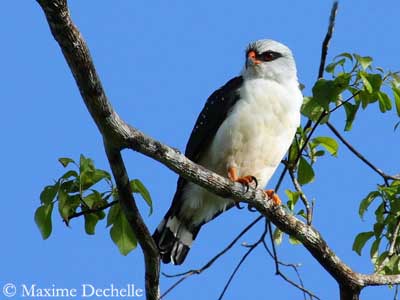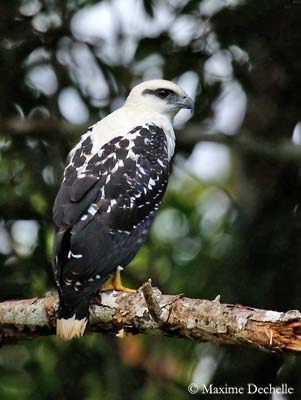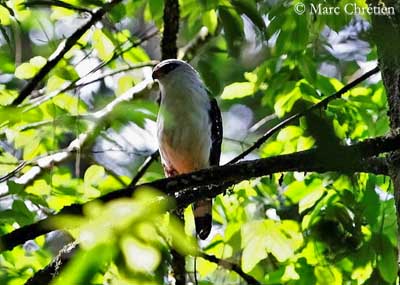
Black-faced Hawk
Leucopternis melanops
Accipitriforme Order – Accipitridae Family
BIOMETRICS :
Length: 38-41 cm
Weight: 295-315 g
DESCRIPTION:
The Black-faced Hawk is a medium-sized black and white raptor.
Adult has white upperback, head, neck and underparts. Crown and lower nape are finely streaked black.
Wings are black. Coverts and scapulars are conspicuously spotted white. Tail is black with median white band and narrow terminal white tip.
The underwing is mainly white with flight feathers barred at tips.
DIET:
Black-faced Hawk feeds on reptiles such as snakes and lizards. It also takes nestlings at nest, invertebrates and large insects.
PROTECTION / THREATS / STATUS:
Black-faced Hawk is not threatened. This very secretive bird is rarely seen. At this moment, there still are forests within the range, and this species does not suffer habitat loss.
Fr : Buse à face noire
All : Zügelbussard
Esp: Busardo Carinegro
Ital: Poiana faccianera
Nd: Zwartmaskerbuizerd
Russe: Пегий канюк
Photographers:
Marc Chrétien
MURINUS
Maxime Dechelle
LEPAPARRAZO
Patrick Ingremeau
TAMANDUA
Text by Nicole Bouglouan
Sources :
HANDBOOK OF THE BIRDS OF THE WORLD Vol 2 by Josep del Hoyo-Andrew Elliot-Jordi Sargatal - Lynx Edicions - ISBN: 8487334156
A GUIDE TO THE BIRDS OF COLOMBIA by Steven L. Hilty and William L. Brown - Princeton University Press – ISBN 069108372X
RAPTORS OS THE WORLD by James Ferguson-Lee – Helm Field Guides – ISBN: 0713669578
Arthur Grosset's Birds (Arthur Grosset)
BirdLife International (BirdLife International)
XENO-CANTO AMERICA – Birds sounds from the Americas

On the face, lores are black, and the brown eyes are surrounded by black, wide eye ring forming black mask.
The hooked bill has red-orange to orange-yellow cere and black tip. Legs and feet are similar in colour, with black claws.
The Black-faced Hawk is very similar to the White Hawk (Pseudastur albicollis), but it is smaller and differs by head pattern, bill and legs’ colours and tail pattern.
It also differs from the White-browed Hawk (Leucopternis kuhli) by head pattern. The latter has black head with conspicuous white eyebrow. (Not displayed)

White Hawk
Pseudastur albicollis
Black-faced Hawk
Leucopternis melanops
Both sexes are similar, with female slightly larger than male.
Immature has white plumage tinged buff on back and upperwing. The fine streaks are less conspicuous on head and neck.
VOICE: SOUNDS BY XENO-CANTO
As most of the birds of prey, the Black-faced Hawk is more vocal during the breeding season.
This bird utters high-pitched call when perched, two short notes “peeeooh”, while it raises the head.
We can also hear thin, plaintive whistles repeated several times.
HABITAT:
Black-faced Hawk frequents moist lowland forest, and primarily the dense cover of vegetation along river banks and streams, and mangroves.
RANGE:
Black-faced Hawk is found in the Guianas and Amazonia (N Amazon Basin of Brazil). It is also present in Colombia, Ecuador, Peru and Venezuela.
BEHAVIOUR:
Black-faced Hawk probably feeds on reptiles, from observation reports. The bird eats snakes on the ground after removed the head. Also seen with a lizard as prey, and preying on Dove’s chicks.
The long claws allow this raptor to hunt for food and to catch the preys with the talons.
Black-faced Hawk rarely perches on exposed branch, but it can be seen perched in open on sunny mornings.
This species is probably resident within the range.
Courtship displays are unknown.
FLIGHT:
Black-faced Hawk performs short glides interspersed with fast shallow wing beats. Rarely seen soaring.
REPRODUCTION:
Any information available at this moment.
However, as some other “Leucopternis” hawks, the Black-faced Hawk probably builds a stick nest in tall tree, where both parents incubate the eggs during about five weeks.
The young may have long dependency period after fledging, about 3-4 months after leaving the nest.
